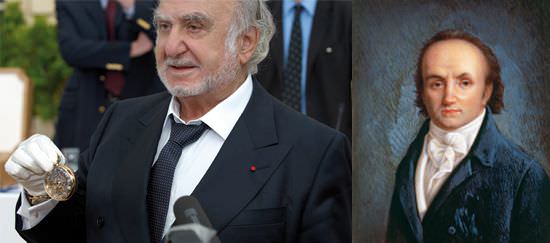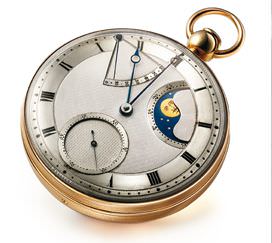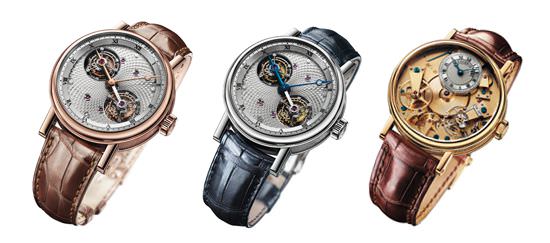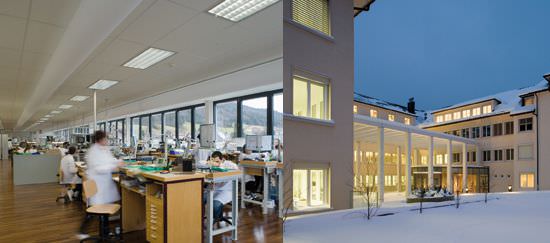“Since the 1780s, with his series of complicated perpetual calendars, Abraham-Louis Breguet was the leader in nearly all branches of timekeeping,” writes historian David S. Landes in his reference book, Revolution in Time: Clocks and the Making of Modern World. A bit further, Landes continues, “After Breguet, watches were at best only copies of his models or his concepts.” Obviously, the genius from NeuchÂtel made his mark on timekeeping History, with a capital H. And with no displeasure to France, which has a tendency to appropriate him, Abraham-Louis was indeed Swiss, even though the company created by him and bearing his name was established in Paris in 1775.
But as inconceivable as it may seem, the inventor of the tourbillon, one of the most beautiful and difficult complications in existence, had fallen into nearly total oblivion ten years ago. Just imagine watchmaking without Breguet - it would be like Italian opera without Verdi.

Nicolas G. Hayek - Abraham-Louis Breguet
Acquired for CHF 250 million
It was only in 1999 that his company returned to the forefront of the industry. In September of that year, Investcorp, an investment company in Bahrain, wanted to divest itself of its watch pole, which included Ebel, Chaumet, Breguet and the movement manufacturer Nouvelle LÉmania. Nicolas G. Hayek, the president of the board of directors of the Swatch Group, the world’s largest watch organization, was interested in this sale, but only for Breguet and Nouvelle LÉmania. “Now that it’s ancient history, I guess I can tell you that we purchased the two brands for approximately CHF 250 million, including their debt, without speaking of the recapitalization of the pension fund,” explains the patriarch of Swiss timekeeping. The other two brands, Ebel and Chaumet, were acquired by the luxury group LVMH for $460 million.
Welcoming Europa Star for our interview, Nicolas G. Hayek, who is now 81 years old, sits behind the desk in his office in L’Abbaye, a small village in Vaud in the VallÉe de Joux, at 1000 metres of altitude. Outside, the sun is shining brightly - even dazzling as it reflects off the expansive snow that has fallen this year in the region. We are far from the frenzy of the world’s capitals. Yet it is from here that the president of the Manufacture Breguet has re-gilded the brand with the brilliant lustre that it enjoyed long ago. In ten years, Breguet has come to the forefront of timekeeping. Better yet, the company has again found its place in the watchmaking pantheon - a place that it should never have left.
Hayek admits this without beating around the bush. “It was only later that I realized the pearl that I had between my hands with Breguet - the perfect object that people could become passionate about.” Although he purchased both companies, under rather incredible conditions that he describes in his book, his primary goal was to obtain Nouvelle LÉmania, the company that supplies movements to the Swatch Group’s Omega for its Speedmaster collection (the watch that went to the moon). It was unthinkable, therefore, that the movement maker should pass into the hands of the competition. The love for Breguet followed, as naturally as a river flows along its bed.

Breguet n°5
Total makeover
The president of the Swatch Group, who was still the group’s CEO, took charge of Montres Breguet himself. He revisited everything and surrounded himself with devoted men who were also convinced that the brand could make a successful comeback. The work, however, was colossal. Under Investcorp, Breguet realized sales of around CHF 40 million for approximately 4,000 watches. The brand was clearly under-capitalized, and just barely managed to keep afloat. Worse yet, the tourbillon had nearly disappeared from a collection that was essentially composed of sports watches, with the flagship of the era being the Type XX.
In parallel to a complete overhaul of the brand’s marketing, with the two famous ad campaigns (famous clients and literary citations), the new boss directed that the accent would be placed on high complications and, in particular, on the tourbillon, which had, in its glorious ancient heyday, seduced Europe from London to Saint Petersburg. Returning to the tourbillon was only natural since this invention was one of the main elements that made Abraham-Louis Breguet’s reputation, and for which he filed a patent in 1801.
While Abraham-Louis sold 35 tourbillon watches during his lifetime, the brand’s production today is more than 1,000 pieces, according to our estimates. Nicolas G. Hayek, who continues to supervise everything from design to production to sales, still oversees the near totality of the collections. Breguet also benefits from the Swatch Group’s vast distribution network. Out of concern for rationalisation and efficiency, Nouvelle LÉmania was merged into Breguet, thus giving birth to the Manufacture Breguet, which takes care of the overall production. With the exception of the spirals (Nivarox), the cases, and a few rare movements entrusted to FrÉdÉric Piguet (also part of the Swatch Group), everything else is made in-house.
A short decade later and with investments of CHF 80 million providing growth, renovations, and expansion of the production tool, Breguet took on a totally new look. The brand has also moved upmarket, to regain its place at the summit of Haute Horlogerie. Sales have followed suit in a nearly exponential manner. You be the judge. Sales increased by a factor of ten. “We have more than CHF 500 million in sales every year, and create more than 42,000 watches and movements per year,” explains Hayek. The brand’s earlier financial difficulties have been supplanted by an impressive profitability, with nearly 35 per cent of operational margin - without even mentioning the ability to generate enormous cash flow. This is largely enough for the brand to finance its own investments. The number of employees has also grown. Today, 685 people work between the sites at L’Orient (production) and L’Abbaye (administrative headquarters). The brand has also opened its own boutiques, now numbering 14, compared to none before. Another four will be inaugurated this year, in spite of the current economic malaise.

DOUBLE TOURBILLON - TRADITION
The crisis?
In regards to the economic situation, what is the impact of the recession on the very haut de gamme sector? “Breguet is doing better than just resisting in this climate. Of course, in some countries, our sales are declining, but in others, we are seeing surprising increases.” The year 2008 ended with hardly any stock left. In spite of the slump, however, Hayek has not reduced Breguet’s production. The brand new CNC equipment is operational during three eight-hour shifts and watchmakers and artisans are employed full time. “As of now, we have a little stock, enough for two and a half months, but not in the area of grand complications. For them, we cannot meet demand. Having said that, these stocks are completely manageable. Breguet has not flooded its retailers in order to artificially inflate the numbers, contrary to some of our competitors,” he adds. Duly noted.

The Tradition
To illustrate the total overhaul of the collection, we can cite the Tradition, which has obtained many awards and which continues to carry the brand. Inspired by a subscription watch, this creation introduced one of the most important inventions of Abraham-Louis Breguet - the parachute, developed in 1790. The parachute’s function is to protect the balance staff pivot from axial shocks. The updated Tradition has a new movement, which required four years of development and which was completely designed and produced by the Manufacture. The timepiece showcases its bridges, wheels, escapement, barrel, and other components of the movement that are normally hidden under the plate. The Tradition has served as an inspiration for other brands, especially in terms of its design.
The double tourbillon
As a second example, we mention the rotating double tourbillon watch, whose demand remains constant despite a price tag of around CHF 400,000 - or even double that for the diamond-set version. Two tourbillons, each independent from one another, are coupled by means of a differential gearing mechanism and attached to a central rotating plate (one complete rotation occurs over twelve hours). The differentials transmit the average rate of the two tourbillons to the central rotating plate and to the hour display. This allows the barrels to be wound simultaneously while guaranteeing their equal winding. The watch’s operation is therefore the average of that of the two tourbillons, which means that it is twice as precise as a normal movement. The errors in the isochronism of the oscillators in the vertical positions are thus cancelled out.
The Queen of Naples and Marie-Antoinette
Hayek has also created a collection of ladies’ timekeepers, which now account for 20 to 30 percent of sales. The Queen of Naples model remains a bestseller since its launch in 2002. Presented for the first time at Baselworld 2008, the re-edition of the Marie-Antoinette pocket watch is one of the great prides of the brand’s president. It is faithful in all ways to the original fabricated by Breguet (it was ordered in 1783 and finished in 1827), despite the controversy currently surrounding the historical piece and the claim by some that it lies hidden in a museum’s vault in Jerusalem. The modern piece features a myriad of complications, including jumping hours, complete perpetual calendar, minute repeater, thermometer, and a time equation. In all, the Marie Antoinette watch includes 823 component parts.

An increase in value of CHF 2.2 billion
While it is definitely looking toward the future, Breguet has not forgotten its historic patrimony. The brand thus continues to look around auction houses, and Nicolas G. Hayek invests some CHF 10 million a year to obtain collectable Breguet pieces or historic models. Emmanuel Breguet, representing the seventh generation of the founder’s family, is respon-sible for travelling the world to purchase watches that Hayek has selected. As a result, the brand’s small museum, located on the first floor of the Breguet boutique on the Place VendÔme in Paris, sees regular additions to its collections. Hayek certainly does not want to stop in the middle of such a busy road, and is setting his sights even higher. A museum project in Switzerland is in the works. Once the details have all been decided, the brand will reveal more.
Beyond the Swatch and the Swatch Group, it is perhaps with Breguet that the clairvoyance and lucidity of the industrial Nicolas G. Hayek are best expressed. “Honestly, I never thought we would arrive at where we are today,” he muses. Ten years ago, some of the group’s management had expressed grave doubts about purchasing Breguet, even to the point of endangering the transaction since the board of directors was supposed to be consulted in order to give its approval before signing any contracts - which Hayek did not do. Today, an American institution values the brand at more than CHF 2.2 billion. This means it has increased in value by 780 percent over a decade. That is quite an appreciation.
As we finish our conversation, Hayek looks far out over the frozen lake in the VallÉe de Joux, which he rebaptized the VallÉe des Bijoux (jewellery). With a small smile on his lips, he contemplates the view. He won’t admit it but he still has hundreds of projects for the brand. The sun continues to shine. It is now at its zenith—a comparison that certainly fits Breguet.
Source: Europa Star April-May 2009 Magazine Issue





